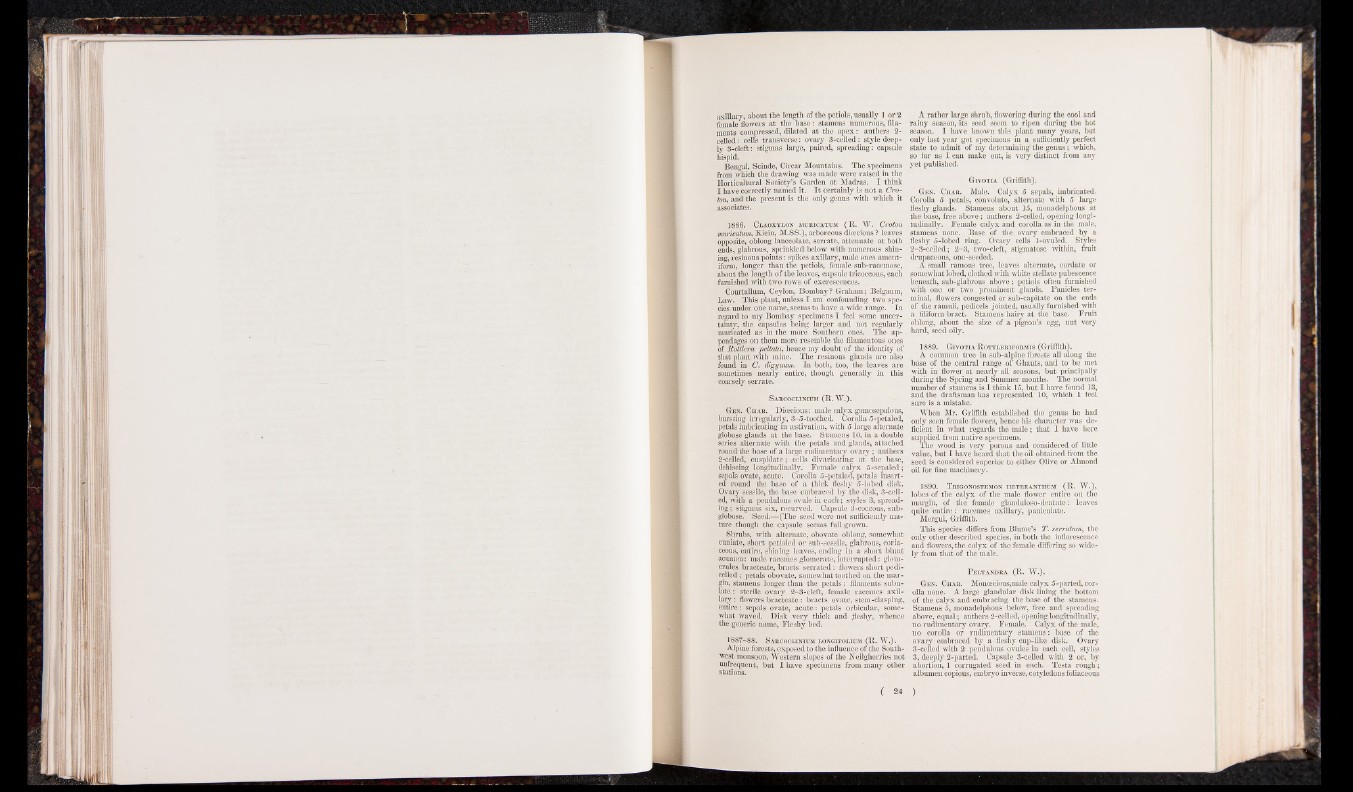
axillary, about the length of the petiols, usually 1 or 2
female flowers at the base: stamens numerous, filaments
compressed, dilated at the apex: anthers 2-
celled: cells transverse: ovary 3-celled: style deeply
3-cleft: stigmas large, paired, spreading: capsule
hispid.
Bengal, Scinde, Circar Mountains. The specimens
from which the drawing was made were raised in the
Horticultural Society’s Garden at Madras. I think
I have correctly named it. I t certainly is not a Croton,
and the present is the only genus with which it
associates.
1886. Claoxylon muricatum (R . W. Croton
muricatum, Klein, M.SS.), arboreous dioecious ? leaves
opposite, oblong ianceolate, serrate, attenuate at both
ends, glabrous, sprinkled below with numerous shining,
resinous points: spikes axillary, male ones ament-
iform, longer than the petiols, female sub-racemose,
about the length of the leaves, capsule tricoccous, each
furnished with two rows of excrescences.
Courtallum, Ceylon, Bombay? Graham; Belgaum,
Law. This plant, unless I am confounding two species
under one name, seems to have a wide range. In
regard to my Bombay specimens I feel some uncertainty,
the capsules being larger and not regularly
muricated as in the more Southern ones. The appendages
on them more resemble the filamentous ones
of Rottlera peltata, hence my doubt of the identity of
that plant with mine. The resinous glands are also
found in C. digynum. In both, too, the leaves are
sometimes nearly entire, though generally in this
coarsely serrate.
Sarcocltnium (R. W.).
Gen. Char. Dioecious: male calyx gamosepalous,
bursting irregularly, 3-5-toothed. Corolla 5-petaled,
petals imbricating in aestivation, with 5 large alternate
globose glands at the base. Stamens 10, in a double
series alternate with the petals and glands, attached
round the base of a large rudimentary ovary; anthers
2-celled, cuspidate; cells divaricating at the base,
dehiscing longitudinally. Female calyx 5-sepaled;
sepals ovate, acute. Corolla 5-petaled, petals inserted
round the base of a thick fleshy 5-lobed disk.
Ovary sessile, the base embraced by the disk, 3-celled,
with a pendulous ovule in each; styles 3, spreading
; stigmas six, recurved. Capsule 3-cocCous, sub-
globose. Seed.—(The seed were not sufficiently mature
though the capsule seems full grown.
Shrubs, with alternate, obovate oblong, somewhat
cuniate, short petioled or sub-sessile, glabrous, coriaceous,
entire, shining leaves, ending in a short blunt
acumen: male racemes glomerate, interrupted: glom-
erules bracteate, bracts serrated: flowers short pedi-
celled; petals obovate, somewhat toothed on the margin,
stamens longer than the petals : filaments subulate
: sterile ovary 2-3-cleft, female racemes axillary
: flowers bracteate : bracts ovate, stem-clasping,,
entire: sepals ovate, acute: petals orbicular, somewhat
waved. Disk very thick and fleshy, whence
the generic name, Fleshy bed.
1887-88. Sarcoclinium longifolium (R. W.).
Alpine forests, exposed to the influence of the Southwest
monsoon, Western slopes of the Neilgherries not
unfrequent, but I have specimens from many other
stations.
A rather large shrub, flowering during the cool and
rainy season, its seed seem to ripen during the hot
season. I have known this plant many years, but
only last year got specimens in a sufficiently perfect
state to admit of my determining-the genus; which,
so far as I can make out, is very distinct from any
yet published.
Givotia (Griffith).
Gen. Char. Male. Calyx 5 sepals, imbricated.
Corolla 5 petals, convolute, alternate with 5 large
fleshy glands. Stamens about 15, monadelphous at
the base, free above; anthers 2-celled, opening longitudinally.
Female calyx and corolla as in the male,
stamens none. Base of the ovary embraced by a
fleshy 5-lobed ring. Ovary cells 1-ovuled. Styles
2 - 3-celled; 2-3, two-cleft, stigmatose within, fruit
drupaceous, one-seeded.
A small ramous tree, leaves alternate, cordate or
somewhat lobed, clothed with white stellate pubescence
beneath, sub-glabrous above; petiols often furnished
with one or two prominent glands. Panicles terminal,
flowers congested or sub-capitate on the ends
of the ramuli, pedicels jointed, usually furnished with
a filiform bract. Stamens hairy at the base. Fruit
oblong, about the size of a pigeon’s egg, nut very
hard, seed oily.
1889. Givotia Rottleriformis (Griffith).
A common tree in sub-alpine forests all along the
base of the central range of Ghauts, and to be met
with in flower at nearly all seasons, but principally
during the Spring and Summer months. The normal
number of stamens is I think 15, but I have found 13,
and the draftsman has represented 10, which I feel
sure is a mistake.
When Mr. Griffith established the genus he had
only seen female flowers, hence his character was deficient
in what regards the male; that I have here
supplied from native specimens.
The wood is very porous and considered of little
value, but I have heard that the oil obtained from the
seed is considered superior to either Olive or Almond
oil for fine machinery.
1890. Trigonostemon heteranthum (R . W.),
lobes of the calyx of the male flower entire on the
margin, of the female glanduloso-dentate: leaves
quite 'entire: racemes axillary, paniculate.
Mergui, Griffith.
This species differs from Blume’s T. serratum, the
only other described species, in both the inflorescence
and flowers, the calyx of the female differing so widely
from that of the male.
Peltandra (R. W.).
Gen. Char. Monoecious,male calyx 5-parted, corolla
none. A large glandular disk lining the bottom
of the calyx and embracing the base of the stamens.
Stamens 5, monadelphous below, free and spreading
above,- equal; anthers 2-celled, opening longitudinally,
no rudimentary ovary. Female. Calyx of the male,
no corolla or rudimentary stamens: base of the
ovary embraced by a fleshy cup-like disk. Ovary
3- ceUed with 2 pendulous ovules in each cell, styles
3, deeply 2-parted. Capsule 3-celled with 2 or, by
abortion, 1 corrugated seed in each. Testa rough;
albumen copious, embryo inverse, cotyledons foliaceous